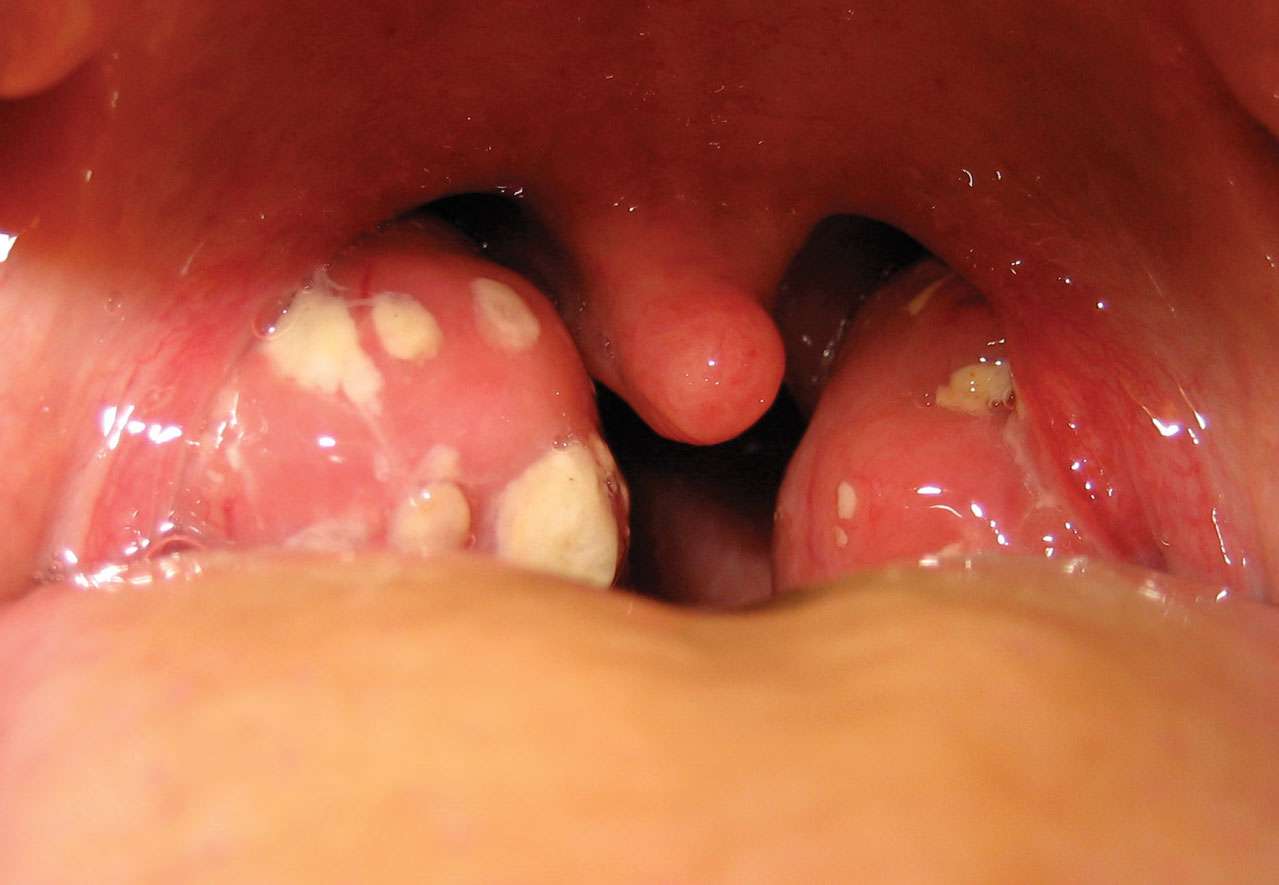What is Tonsillitis?
Tonsillitis is an inflammation of the tonsils, two oval-shaped pads of tissue at the back of the throat, one tonsil on each side. Signs and symptoms of tonsillitis include swollen tonsils, sore throat, difficulty swallowing and tender lymph nodes on the sides of the neck. Most cases of tonsillitis are caused by infection with a common virus, but bacterial infections also may cause tonsillitis.

Opened mouth showing Tonsillitis
Image Credit: Britanica.com
Because appropriate treatment for tonsillitis depends on the cause, it’s important to get a prompt and accurate diagnosis. Surgery to remove tonsils, once a common procedure to treat tonsillitis, is usually performed only when bacterial tonsillitis occurs frequently, doesn’t respond to other treatments or causes serious complications.

Types of tonsillitis
There are different types of tonsillitis that are defined by their symptoms and recovery period.
These include:
- Acute tonsillitis: Symptoms usually last around 3 to 4 days but can last up to 2 weeks.
- Recurrent tonsillitis: A person has many different cases of acute tonsillitis in a year.
- Chronic tonsillitis: Individuals will have an ongoing sore throat and foul-smelling breath.
Causes of tonsillitis
Tonsils are your first line of defense against illness. They produce white blood cells to help your body fight infection. The tonsils combat bacteria and viruses that enter your body through your mouth. However, tonsils are also vulnerable to infection from these invaders.
Tonsillitis can be caused by a virus, such as the common cold, or by a bacterial infection, such as strep throat. According to the American Academy of Family Physicians (AAFP), an estimated 15 to 30 percent of tonsillitis cases are due to bacteria. Most often it’s strep bacteria.
Viruses are the most common cause of tonsillitis. The Epstein-Barr virus can cause tonsillitis, which can also cause mononucleosis.
Children come into close contact with others at school and play, exposing them to a variety of viruses and bacteria. This makes them particularly vulnerable to the germs that cause tonsillitis.
Risk factors of tonsillitis
Risk factors for tonsillitis involve increasing the risk of invasion by pathogenic viruses or bacteria.
- Living or working in close proximity to children
- Living in an urban environment with more exposure to viruses or bacteria
- Being a young child or elderly adult
- Being immunocompromised
- Living or working in close proximity to airborne pollutants, such as smoke
- Living in colder climates
- Suffering from diabetes
- Suffering from cardiac disease
- Excessive and prolonged use of corticosteroids
- Obesity or overweight
Signs and Symptoms of tonsillitis
The most common symptoms of tonsillitis include:
- A sore throat and pain when swallowing
- Red and swollen tonsils with pus-filled spots
- High temperature
- Headache
- Difficulty swallowing
- Pain in the ears and neck
- Tiredness
- Difficulty sleeping
- Coughing
- Chills
- Swollen lymph glands
Less common symptoms can include:
- Fatigue
- Stomach pain and vomiting
- Nausea
- Furry tongue
- Changes in the sound of the voice
- Bad breath
- Difficulty opening the mouth
In some cases, tonsilloliths, also known as tonsil stones or tonsillar calculi, may be present. A tonsillolith is a calcified build-up of material in the crevices of the tonsils.
They are generally small, but in rare cases, tonsilloliths have measured 3 centimeters and above.
Tonsilloliths can be a nuisance
Complications of tonsillitis
Complications of tonsillitis are rare and usually only occur if it’s caused by a bacterial infection. They’re usually the result of the infection spreading to another part of the body.
Possible complications of tonsillitis include:
- A middle ear infection (otitis media) – where fluid between the eardrum and inner ear becomes infected by bacteria
- Quinsy (peritonsillar abscess) – an abscess (collection of pus) that develops between one of the tonsils and the wall of the throat
- Obstructive sleep apnoea (OSA) – where the walls of the throat relax during sleep, which causes breathing difficulties and poor sleep
Other complications of tonsillitis are very rare and usually only occur if an underlying bacterial infection is left untreated. They include:
- Scarlet fever – a condition that causes a distinctive pink-red skin rash
- Rheumatic fever – this causes widespread inflammation throughout the body, leading to symptoms such as joint pain, rashes, and jerky body movements
- Glomerulonephritis – an infection (swelling) of the filters in the kidneys that can cause vomiting and a loss of appetite
How tonsillitis is diagnosed?
Your healthcare provider will ask about your health history and do a physical exam. To guide treatment, your provider may rub a sterile swab over the back of the throat and tonsils to get a sample of the secretions and perform:
- Rapid strep test: This test can detect strep bacteria in minutes
- Throat culture and sensitivity: The sample is cultured in a lab for the presence of bacteria; it helps the provider choose the best antibiotic to treat it, but can take 48 to 72 hours to get the results
Treatment and medications
Treatment of viral tonsillitis primarily involves rest, recovery and symptom relief. It is also important to drink plenty of fluids and have regular meals (soft foods and smoothies are best).
If a bacterial infection is confirmed by a throat culture, antibiotics will be prescribed to prevent complications, particularly rheumatic fever and kidney disease. It is important to take the full course of antibiotics as prescribed to prevent the infection from returning and to reduce the likelihood of developing rheumatic fever or kidney disease. Refer to our strep throat page for more information.
Antibiotics will not be prescribed for viral tonsillitis because antibiotics are not effective against viruses. Viral tonsillitis will usually get better without treatment. Pain relief and reduction of fever can be achieved with over-the-counter paracetamol and ibuprofen.
Gargling salt water (half teaspoon of salt to a cup of warm water) may provide some symptom relief as may sucking on hard sweets or throat lozenges containing ingredients that are cooling, anesthetic, antiseptic, or anti-inflammatory.
Corticosteroids such as dexamethasone or prednisone may be prescribed to reduce inflammation and swelling, particularly when it is making swallowing and breathing difficult.
Surgery
Some people who have recurring bouts of tonsillitis will be offered surgery to remove their tonsils. The operation is known as a tonsillectomy.

Removing infected tonsils
Image Credit: WikiHow
People who have a tonsillectomy need a general anesthetic and often stay in hospital overnight. There is a risk of heavy bleeding after the operation. It doesn’t prevent sore throats from recurring. Some people have a lot of pain afterward, and it can take up to 2 weeks to recover.
You should talk to your doctor or ear, nose and throat specialist about whether a tonsillectomy is likely to help you.
What natural or home remedies help soothe tonsillitis pain and inflammation?
If a doctor has diagnosed tonsillitis, some home remedies can help soothe the symptoms of a sore throat.
- Throat sprays and lozenges: These can coat and moisturize the throat, and many have a topical anesthetic to relieve pain (consult a doctor before giving lozenges to young children; they can be a choking hazard)
- Saltwater gargle: This helps clear mucus from the throat
- Sipping warm beverages such as tea with honey, or broth can be soothing
- Eating cold foods such as ice cream or popsicles can help ease pain
Some alternative remedies may help ease tonsillitis symptoms.
- Slippery elm in lozenge form may help with pain relief
- Serrapeptase is an enzyme that has anti-inflammatory properties and can help decrease pain and help with swallowing
- Papain is an enzyme that can help treat inflammation
- Andrographis can help treat fever and sore throat symptoms
Consult your doctor before using any alternative remedies. Doctors do not recommend many of these home remedies for use in children or adolescents as most have not been scientifically evaluated.
Prevention of tonsilitis
The germs that cause viral and bacterial tonsillitis are contagious. Therefore, the best prevention is to practice good hygiene. Teach your child to:
- Wash his or her hands thoroughly and frequently, especially after using the toilet and before eating
- Avoid sharing food, drinking glasses, water bottles or utensils
- Replace his or her toothbrush after being diagnosed with tonsillitis
To help your child prevent the spread of a bacterial or viral infection to others:
- Keep your child at home when he or she is ill
- Ask your doctor when it’s all right for your child to return to school
- Teach your child to cough or sneeze into a tissue or, when necessary, into his or her elbow
- Teach your child to wash his or her hands after sneezing or coughing

 Entertainment3 months ago
Entertainment3 months ago
 Celeb Gossip3 months ago
Celeb Gossip3 months ago
 News3 months ago
News3 months ago
 News3 months ago
News3 months ago
 World News3 months ago
World News3 months ago
 News2 months ago
News2 months ago
 World News1 month ago
World News1 month ago
 News1 month ago
News1 month ago









